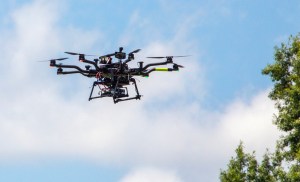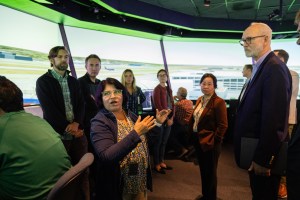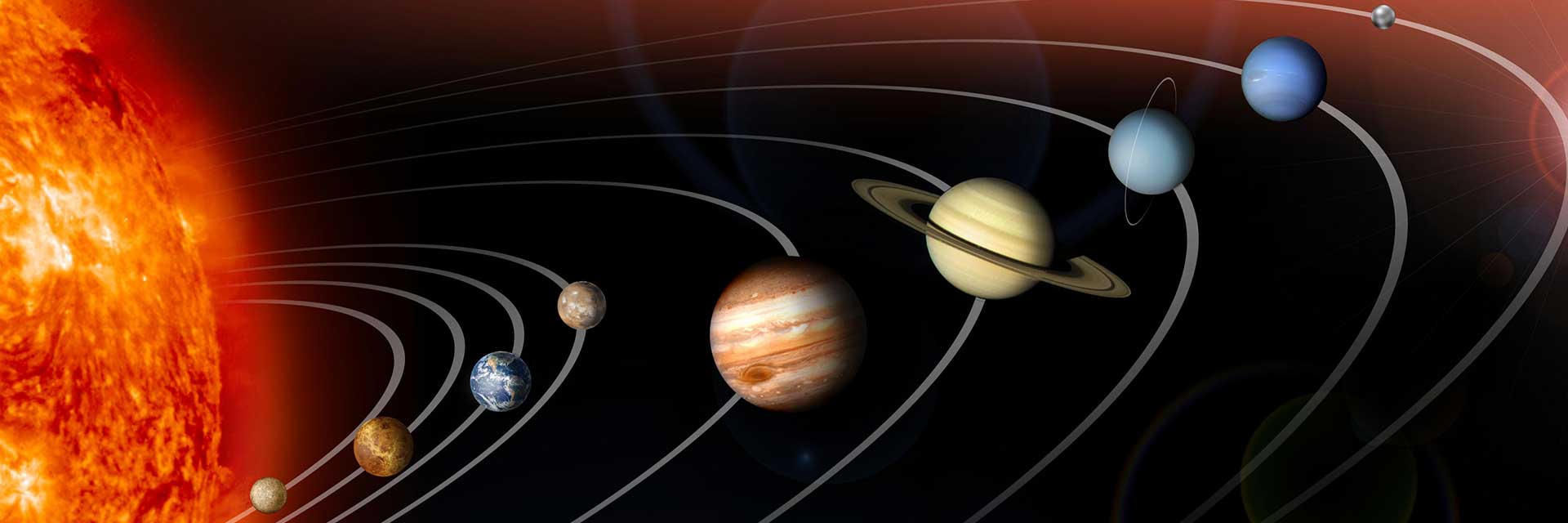NASA Advanced Air Mobility Partnerships
NASA is partnered with other government agencies, industry, and academia to conduct Advanced Air Mobility (AAM) research to benefit a future transportation system with routine flight of air taxis and drones. See the current partnerships below and in the map above. AerostarSioux Falls, South DakotaNASA and Aerostar are conducting collaborative evaluation of a NASA prototype […]

12 min read
Preparations for Next Moonwalk Simulations Underway (and Underwater)

NASA is partnered with other government agencies, industry, and academia to conduct Advanced Air Mobility (AAM) research to benefit a future transportation system with routine flight of air taxis and drones. See the current partnerships below and in the map above.
Aerostar
Sioux Falls, South Dakota
NASA and Aerostar are conducting collaborative evaluation of a NASA prototype simulated Upper Class E Traffic Management (ETM) system.
AeroVironment
Simi Valley, California
NASA and AeroVironment are conducting research, development, testing, and evaluation of a NASA prototype simulated Upper Class E Traffic Management (ETM) system.
AFWERX – U.S. Air Force
Wright-Patterson Air Force Base, Ohio
NASA and AFWERX have ongoing information exchange efforts across multiple AAM areas. NASA is using Joby’s air taxi aircraft for testing at Edwards Air Force Base in partnership with the U.S. Air Force’s AFWERX program.
Air Force Research Laboratory Aerospace Systems Directorate (AFRL)
Wright-Patterson Air Force Base, Ohio
NASA and AFRL are sharing data about autonomous systems in AAM vehicles, airspace management systems, and infrastructure. Research includes configuration of formal methods, control systems validation, and flight critical software verification and validation.
AIRT
Miami, Florida
NASA and AIRT are developing a safety management system to enable highly-automated AAM-focused aviation for emergency response.
A&P Technology
Cincinnati, Ohio
NASA and A&P Technology are developing new braided composite materials to improve the crash safety of composite aircraft. A&P Technology and NASA will work together from the design phase, to fabrication, to dynamic crush test experiments on the materials.
Archer Aviation
San Jose, California
NASA and Archer will focus on testing the safety, energy and power performance capabilities of the Archer air taxi’s battery cells at NASA’s Johnson Space Center. The goal is to jointly improve overall safety of AAM and human spacecraft battery applications.
AURA Network Systems
McLean, Virginia
NASA and AURA Network Systems will perform AAM flight test evaluations of Communication, Navigation, and Surveillance (CNS) technologies to advance the maturity of these technologies for AAM aircraft.
The City of Orlando
Orlando, Florida
NASA is working with city and state governments to brainstorm the ways that air taxis and drones, and the infrastructure for this new transportation system, could be integrated into city planning. NASA is exchanging information with these governments to identify the best practices for how a local government could design this system. Each city or state government involved will create a joint document with NASA using computer modeling software to describe how this could work in their locality.
Boeing
Huntsville, Alabama
NASA and Boeing are researching the integration, demonstration, and evaluation of autonomous systems and tools to support AI standardization.
Defense Advanced Research Projects Agency (DARPA)
Arlington, Virginia
NASA and Lockheed Martin – Sikorsky are working together with DARPA under a DARPA agreement to research air taxi automation technology using Sikorsky helicopters. In a separate effort, NASA is working with DARPA on the Automated Rapid Certification Of Software (ARCOS) program, which will aid in developing the criteria for automation software certification.
Embry-Riddle Aeronautical University
Daytona Beach, Florida
NASA and Embry-Riddle are examining existing mishap data collected from the NASA Human Contribution to Safety (HC2S) test bed, and data collected independently, to identify realistic, actionable methods to promote better response to disturbances in flight.
DLR – German Aerospace Center
Braunschweig, Germany
Cologne, Germany
NASA and DLR researchers are designing algorithms and conducting fast-time simulations to help address the challenges of a future air traffic management system with more aircraft. In a separate effort, NASA and DLR are researching the air flow generated by rotary wing aircraft. The team is using visual tools like schlieren and shadowgraph techniques to see the directions of airflow invisible to the naked eye.
General Electric Company
Niskayuna, New York
NASA and General Electric Company are researching flight safety in autonomous systems. Efforts focus on assurance of flight-critical systems (including airborne and ground software systems), human autonomy teaming, and efficient airspace operations.
George Washington University
Washington, D.C.
NASA and several universities are demonstrating a NASA-created safety management system called “In-Time Learning-Based Safety Management for Scalable Heterogeneous AAM Operations.” This is a combined effort with George Washington University, Vanderbilt University, MIT/Lincoln Labs, and UT-Austin.
Iowa State
Ames, Iowa
NASA, Iowa State and Notre Dame University are developing and evaluating automated techniques for predicting, detecting, diagnosing, and mitigating diverse configuration problems and runtime failures in small Uncrewed Aerial Systems (sUAS), also called drones.
Joby Aviation
Santa Cruz, California
NASA and Joby are testing the human response to autonomy to find management solutions for autonomous air taxis using only a small number of human ground operators. This research will lead to a better understanding of technology solutions needed to ensure safe, routine, multi-aircraft AAM flights. In another effort, in partnership with the U.S. Air Force’s AFWERX program, NASA is using Joby’s aircraft for testing at Edwards Air Force Base.
Lockheed Martin – Sikorsky
Bridgeport, Connecticut
NASA and Lockheed Martin – Sikorsky are conducting dynamic crush and ballistic impact testing of new woven composite materials. The test material will be provided by Lockheed Martin and NASA will conduct the testing. The goal is to improve NASA’s impact modeling capabilities and to improve the crash safety of future composite aircraft.
Lone Star UAS Center of Excellence and Innovation at Texas A&M University
Corpus Christi, Texas
NASA and the Lone Star UAS Center of Excellence and Innovation are developing and testing new AAM technologies through experiments, measurements, and flight tests.
Longbow
Hampton, Virginia
NASA and Longbow will conduct collaborative flight tests and use NASA-developed prognostic services to increase situational awareness and decrease exposure to hazards.
Massachusetts Department of Transportation
Boston, Massachusetts
NASA is working with city and state governments to brainstorm the ways that air taxis and drones, and the infrastructure for this new transportation system, could be integrated into city planning. NASA is exchanging information with these governments to identify the best practices for how a local government could design this system. Each city or state government involved will create a joint document with NASA using computer modeling software to describe how this could work in their locality.
Massachusetts Institute of Technology (MIT)
Cambridge, Massachusetts
NASA and MIT are capturing the human contribution to safety and are developing methods to increase safety in autonomous systems like training a machine to “see” the obstacles that a human would see.
Minnesota Department of Transportation
St. Paul, Minnesota
NASA is working with city and state governments to brainstorm the ways that air taxis and drones, and the infrastructure for this new transportation system, could be integrated into city planning. NASA is exchanging information with these governments to identify the best practices for how a local government could design this system. Each city or state government involved will create a joint document with NASA using computer modeling software to describe how this could work in their locality.
MIT/Lincoln Labs
Lexington, Massachusetts
NASA and several universities are demonstrating a NASA-created safety management system called “In-Time Learning-Based Safety Management for Scalable Heterogeneous AAM Operations.” This is a combined effort with George Washington University, Vanderbilt University, MIT/Lincoln Labs, and UT-Austin.
Mitre
Bedford, Massachusetts
NASA and Mitre are researching the accuracy of positioning, navigation, and timing (PNT) of different aviation navigation systems in modeling and simulation. In a separate agreement, NASA and Mitre are developing a service to predict GPS connectivity in urban areas to help adapt pre-flight and in flight routes for AAM aircraft.
Moog
East Aurora, New York
NASA is partnered with Moog to conduct acoustic testing of their SureFly aircraft. Moog is providing the test vehicle and executing the flight test, while NASA is collecting acoustic data during the tests using an array of ground microphones. These acoustic measurements will provide valuable data used to improve NASA’s noise prediction tools for air taxis.
National Institute of Standards and Technology (NIST)
Gaithersburg, Maryland
NASA and NIST are investigating software for autonomous vehicles to improve the software verification and coordination.
North Central Texas Council of Governments
Arlington, Texas
NASA is working with city and state governments to brainstorm the ways that air taxis and drones, and the infrastructure for this new transportation system, could be integrated into city planning. NASA is exchanging information with these governments to identify the best practices for how a local government could design this system. Each city or state government involved will create a joint document with NASA using computer modeling software to describe how this could work in their locality.
Northrop Grumman
West Falls Church, Virginia
Palmdale, California
NASA and Northrop Grumman are investigating the use of large Uncrewed Aircraft Systems (UAS) for cargo transportation between airports and/or other National Airspace System (NAS) access points.
Notre Dame University
South Bend, Indiana
NASA, Notre Dame and Iowa State are developing and evaluating automated techniques for predicting, detecting, diagnosing, and mitigating diverse configuration problems and runtime failures in small Uncrewed Aerial Systems (sUAS), also called drones.
Ohio Department of Transportation (ODOT)
Springfield, Ohio
NASA and ODOT will share critical flight and ground operations safety data during flight tests. These flight tests will help evaluate safety management systems for highly-automated aircraft. In a separate effort, NASA and ODOT are exchanging information to advance autonomous cargo aircraft operations. NASA is also working with ODOT to brainstorm the ways that air taxis and drones, and the infrastructure for this new transportation system, could be integrated into city planning by creating a joint document with NASA using computer modeling software to describe how this could work in their locality.
Old Dominion University
Norfolk, Virginia
NASA and Old Dominion University are conducting studies focusing on the collaboration between humans and autonomous systems to see how the two would work together to manage large numbers of autonomous AAM flights. NASA is developing a Human Autonomy Teaming Task Battery to evaluate performance and workload for a human working with an autonomous system.
ONERA (Office National d’Etudes et de Recherches Aérospatiales) – The French Aerospace Lab
Palaiseau, France
In one effort, NASA and ONERA are using computational fluid dynamics (CFD), or the use of mathematics, physics and computational software to visualize how a gas or liquid flows, for broadband noise prediction of a hovering rotor to advance broadband noise prediction capabilities for AAM aircraft. In another effort, NASA and ONERA are collaborating on the acoustics modeling of ducted rotors with optimized liners. These findings will be used to improve the acoustic performance of future tilt-duct aircraft.
Penn State University
State College, Pennsylvania
NASA and Penn State are developing safe role allocations and communication between human-to-human or human-to-machine communication to assure new delegations of authority and responsibility will work in autonomous systems.
Stanford University
Stanford, California
NASA and Stanford are developing and demonstrating a framework for providing algorithmic assurances and designing fault detection, isolation, and recovery (FDIR) methods for those components of the autonomy stack that rely on data-driven methods based on machine learning.
University Of Central Florida (UCF)
Orlando, Florida
NASA is working with UCF to improve the safety of drones through data-driven predictive analytics.
Université de Sherbrooke
Quebec, Canada
NASA and Université de Sherbrooke are investigating the noise generated by fundamental airfoil shapes. NASA will provide customized test articles that will be tested in the University’s anechoic wind tunnel facility. The findings will be used to improve noise predictions for a wide variety of aircraft.
U.S. Army Combat Capabilities Development Command (DEVCOM) and U.S. Navy Office of Naval Research (ONR)
Moffett Field, California
Arlington, Virginia
Effort between NASA, DEVCOM and ONR to fund the Vertical Lift Research Centers of Excellence (VLRCOE). The VLRCOE program was renewed in 2021, with three awardees selected to receive approximately $22M in funding over five years. The Georgia Institute of Technology, Penn State University, and the University of Maryland were selected to perform research on a wide variety of vertical lift technology topics. In addition to establishing a workforce pipeline, this effort will help improve the safety, performance and affordability of civilian and military helicopters and other vertical lift aircraft.
University of Texas
Austin, Texas
NASA and several universities are demonstrating a NASA-created safety management system called “In-Time Learning-Based Safety Management for Scalable Heterogeneous AAM Operations.” This is a combined effort with George Washington University, Vanderbilt University, MIT/Lincoln Labs, and UT-Austin.
Vanderbilt University
Nashville, Tennessee
NASA and several universities are demonstrating a NASA-created safety management system called “In-Time Learning-Based Safety Management for Scalable Heterogeneous AAM Operations.” This is a combined effort with George Washington University, Vanderbilt University, MIT/Lincoln Labs, and UT-Austin.
Virginia Commonwealth University (VCU)
Richmond, Virginia
NASA, VCU and NIST are developing and evaluating an integrated model- and data-driven approach for risk monitoring to identify and predict elevated risk states for known risk(s) in autonomous technology.
Wisk
Mountain View, California
NASA and Wisk are testing the human response to autonomy to find management solutions for autonomous air taxis using only a small number of human ground operators. This research will lead to a better understanding of technology solutions needed to ensure safe, routine, multi-aircraft AAM flights.
Xwing
San Francisco, California
NASA and Xwing are sharing critical flight and ground operations data, algorithms, and evaluating safety management systems to ensure autonomous aircraft operations are safe.
Zipline
San Francisco, California
NASA and Zipline are testing the human response to autonomy to find management solutions for autonomous air taxis using only a small number of human ground operators. This research will lead to a better understanding of technology solutions needed to ensure safe, routine, multi-aircraft AAM flights.
Active NASA Space Act Agreements and NASA Interagency Agreements that relate to Advanced Air Mobility (AAM) are listed here. NASA does not endorse any entity listed here. NASA works with research partners under these agreements to improve technology for the entire AAM industry’s benefit.
Partnerships Contact
Jamie Turner
Media Contact
Teresa Whiting
Share
Related Terms
What's Your Reaction?
















































